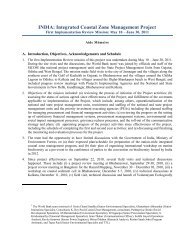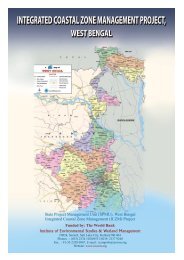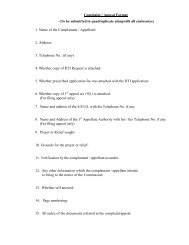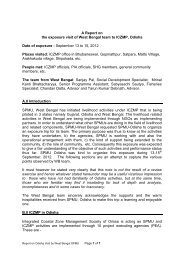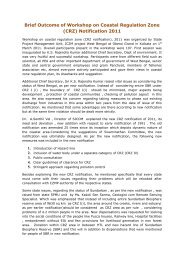Cyclone and Storm Surge - Iczmpwb.org
Cyclone and Storm Surge - Iczmpwb.org
Cyclone and Storm Surge - Iczmpwb.org
You also want an ePaper? Increase the reach of your titles
YUMPU automatically turns print PDFs into web optimized ePapers that Google loves.
1.2<br />
IMD, in its website (http://www.imdmumbai.gov.in/cycdisasters.htm) article on the surge prone coasts<br />
of India also mentions that the vulnerability to storm surges is not uniform along Indian coasts. The<br />
following segments of the east coast of India are most vulnerable to high surges:<br />
1. North Orissa <strong>and</strong> West Bengal coasts.<br />
2. Andhra Pradesh coast between Ongole <strong>and</strong> Machilipatnam.<br />
3. Tamil Nadu coast, south of Nagapatnam.<br />
It may be of interest to note that the West coast of India is less vulnerable to storm surges than the<br />
east coast of India in terms of both the height of storm surge as well as frequency of occurrence.<br />
The strong winds associated with a cyclone may destroy infrastructure, including dwelling houses<br />
especially if these are the rural thatched types with mud walls. It must be remembered that the<br />
regions very prone to cyclonic storms lie along the coastline <strong>and</strong> the socio-economic st<strong>and</strong>ard of the<br />
people residing here is, on an average, rather low except for the few towns. It is also well known that<br />
cyclonic storms are also associated with heavy precipitation. Hence, inundation by flooding due to<br />
high rainfall is also considered as a disaster related to tropical cyclones.<br />
The table of disasters in India (for the entire nineteenth century) presented in the UNDP website<br />
under the title “Disaster Related Database” also shows that the State of West Bengal has suffered<br />
the worst due to cyclonic storms, followed by floods, droughts <strong>and</strong> earthquakes. Hence, the present<br />
task of evaluating the hazard caused by cyclones to the state <strong>and</strong> recommendations of mitigation<br />
measures has been the result of a prudent <strong>and</strong> timely decision.<br />
1.2. Background, key concepts <strong>and</strong> methodology<br />
The project was initiated at the request of the Department of Relief, Government of West Bengal after<br />
an initial meeting that took place in June, 2005 at Writer’s Building’s, Kolkata. It emerged from this<br />
<strong>and</strong> the subsequent meetings that the loss of lives <strong>and</strong> property due to cyclones having been quite<br />
heavy for the State, there is an urgent need to evaluate the hazard <strong>and</strong> vulnerability of the different<br />
cyclone prone regions <strong>and</strong> suggest possible disaster mitigation measures. It was also decided that<br />
the suggestive measures should more or less be in the lines of National <strong>Cyclone</strong> Risk Mitigation<br />
Project (NCRMP) guidelines.<br />
The core of the project lies in the determination of the following:<br />
1. Hazard analysis: This includes the study of cyclone tracks <strong>and</strong> related information for past<br />
years as available <strong>and</strong> evaluation of the hazard to the different parts of the state that are









